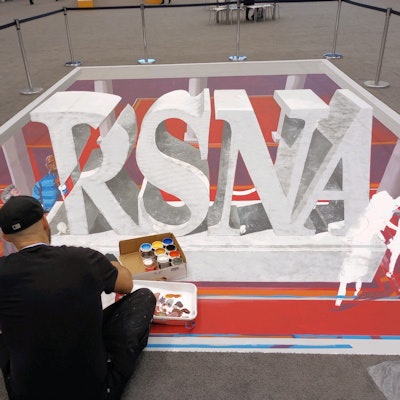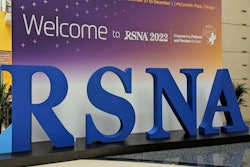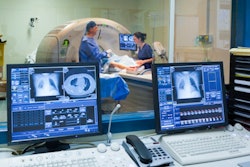
When it comes to stark challenges facing radiology in a post-COVID world, there are three substantial issues:
- A global shortage of radiologists, technicians, and imaging service-line personnel
- Increasing demand for imaging services, especially outside of the hospital
- Inefficient and siloed informatics systems
All were evident at the recent RSNA meeting. The congress provided a hint of the cutting-edge future of radiology. But, in reality, new advanced imaging modality and informatics products exclusive to the 2022 show were relatively thin on the ground.
 Steve Holloway of Signify Research.
Steve Holloway of Signify Research.The "heady" days of extravagant modality and IT launches may therefore have run their course -- above all, and perhaps rightly, reflecting the current tide of economic stressors facing healthcare providers, the RSNA was wholly concerned with frugality in 2022.
Trimmed down vendor booths, greater focus on efficiency, and cost of ownership across new product releases were woven amongst the biggest booths. The artificial intelligence (AI) zone also included a "refreshed" AI exhibitor group, featuring a mix of increasingly established and assured market front-runners, a myriad of new platforms, plus a few expectant fresh logos hoping to capitalize where others had already failed.
Positively, post-COVID market forces had also been at work, shedding previously conspicuous exhibitors (well, at least in the case of DeepRadiology) and asking more searching questions of the clinical and economic validity of market participants. Combined, this all pointed to the commercial radiology sector getting a little more "real" about the challenges ahead.
Scarcity of product launches
Overall, new product announcements were scarce, and for those that were released, many were targeted at filling gaps in portfolios/addressing particular customer segments, as opposed to portfolio-shaping new platforms. This was unsurprising given the COVID-19 distraction and disruption to the innovation cycle, with many vendor discussions pointing to more "disruptive" product releases on the near horizon -- the hype for RSNA 2023 is already building.
Some vendors' exhibits (e.g., Canon), focused on clinical workflows, but most vendors did little to move away from presenting products "in category" (e.g., by modality type). While this makes for easy visibility and being directed around the largest booths, the apparent limited focus on care pathways and specific clinical workflows will have disappointed some customers.
Moreover, as integrated, multidisciplinary care pathways are increasingly adopted, the industry will need to more acutely demonstrate the lynchpin role of imaging within wider diagnostics and therapy. This is, in part, also down to the slowly changing evolution of business models -- until commercial contracting models are more complementary to how care is delivered, and providers convinced of the value of moving to more progressive models of financing equipment purchasing (managed services, outcome-based risk sharing) this is unlikely to change quickly.
Vendors were keen to highlight total cost of ownership and sustainability. For modalities, this was particularly evident across new launches and existing products: from the ongoing "helium free" debate in MRI, use of edge AI to reduce the need for contrast agents, smart subscriptions, and the potential role of "extremity" imaging leveraging lower-cost imaging devices, to more tangible focus on leveraging remote diagnostics, smarter fleet management service contracts, and remote acquisition services.
Doing more with the same or less shone through as the leading trend of the show. While this reflects the current focus of the customer-base facing a tough period ahead, it was also clear that vendors still have some way to go in ensuring the "solution" offering they promise will deliver substantial long-term cost savings. While many touted substantial savings within bullish marketing, more customer-led and independent long-term evidence is required to fully convince buyers that these savings are realistic.
CT, MRI, and ultrasound
Broadly, the leading imaging modality vendors doubled down on "big iron" as their leading lights at RSNA 2022. Yet given the influence of COVID-19 on innovation cycles and the fact many have a record order of books yet to be delivered for CT and MR, there were understandably fewer headline grabbers in advanced modalities. What was apparent from vendor discussions, however, was the incoming tide of new CT platforms featuring photon-counting technology in the next two years, spectral CT in the more near term, and the increasingly important role AI will play in image reconstruction.
Combined, these trends will resonate throughout the rest of the decade for big-iron modalities, forming a new era equivalent to (but more subtle than) the CT "slice wars" period decades before. It should not be overlooked, however, that innovation was also apparent at lower-price tiers; new mobile x-ray systems, C-arms, ultrasound, and even some new modalities (see 4DMedical) were all on show.
Ultrasound was the most underserved modality at the show -- given its expansion into tens of new clinical applications across the care continuum, the radiology-centric nature of RSNA has led to some dedicated point-of-care vendors and clinical specialists opting to spend their marketing budget at more targeted shows.
Digitization and health IT
While undertones of digitization trended throughout the imaging modality showcase, many of the software offerings on show were disjointed or still nascent in their availability. Across the categories of preacquisition operations, acquisition (and virtual acquisition support), postacquisition operations, and fleet management, new and novel digital technology has received substantial focus and R&D investment, a positive development to support imaging service providers in solving their biggest challenges.
However, the integration of these tools and interfacing into wider imaging informatics and health IT platforms has some way to go, a potential hindrance for adoption. Reassuringly, the growing focus on use of AI and advanced analytics to support predictive demand forecasting tools and smart scheduling of scans should also be applauded. Given that this technology will not be hamstrung by regulatory barriers, this operational application offers far more tangible benefits to healthcare providers short-term in comparison to some of the venture-funded AI image analysis tools attempting to come to market.
Efficiency and optimization was also a prominent theme among the imaging informatics announcements. More frustrating for some users was the apparent disjointed nature of service line provision of these tools from pre- to postacquisitions. This will come in time, but it also perhaps reflects the slow interoperability programs of leading modality vendors that are leading in this segment.
Dedicated imaging IT platforms were more progressive around radiologist workflow tools, with new generations of case-load balancing, user-friendly interfaces supporting radiologists managing workloads (and avoiding burnout), and further progress on viewer and reporting interface consolidation. The same sentiment is echoed across AI, for which integrated triage tools continue to gain traction and are becoming better interfaced into reporting workflow and care pathways. Reporting tools also took a further step toward more robust structured reporting, though in practice, there appears to be a long road ahead for widespread adoption, despite the obvious future benefits for patient quality and care.
Platforms, platforms, platforms
Vendors from a range of PACS, advanced visualization, AI, modality, reporting, and workflow all sought to demonstrate their prowess in AI integration, with a plethora of new and rebooted AI platforms on show and a growing list of partnerships for more mature platforms. In theory, user "choice" is commonly seen as a positive for customers, yet perhaps the inverse is the case in medical imaging AI; too much choice is leading to market inertia and confusion at a time when imaging service providers have limited resources to assess varied approaches.
While a clear and standardized route to AI access remains unclear, image-analysis tools specifically will be influenced by some wider common market "truths": The power of imaging IT (e.g., PACS) incumbency in customer road-mapping should not be underestimated; customers really do want tightly integrated AI tools (pdf results outputs help no-one); the presence of big technology AI service offerings for imaging at the show (Google, Amazon, Microsoft, NVIDIA) is going to promote more self-development of AI by providers, requiring a more flexible platform integration strategy; reimbursable AI image analysis tools remain the primary draw for customers.
Viewing the explosion of platforms for AI through this lens suggests many of the newly launched platforms will be short-lived. Moreover, with market forces driving impending consolidation of AI algorithm developers midterm, convincing potential customers to look beyond their existing PACS-based platform or one of a few established leading independent platform vendors will be a hard sell.
The consolidation of data?
Surprisingly with many AI vendors facing impending funding challenges and many providers tackling resource and operational challenges, discussions surrounding the potential value of imaging data were scarce at RSNA 2022. While vendor neutral archive (VNA) 2.0 has been touted for some time (and discussed at length in our research) the practical realities of data consolidation have remained subdued.
There was progress on show for imaging IT vendors working on common data consolidation challenges across DICOM-based applications, but wider data ingestion and management of unstructured and interfacing with electronic medical record (EMR)-based clinical data was nascent. The slow progress of structured reporting is in part to blame, yet fundamentally, many of the new integrated care models and demands for more personal, predictive medicine are doomed to fail without more focus on robust data management technology and breaking down data silos within healthcare networks.
In context, this is also a missed opportunity for vendors and providers alike; while still nascent, the growing value of well-structured diagnostic imaging data within the preclinical arena is obvious, with cash-rich pharma vendors post-COVID well underway with massive investment in research digitalization and overhaul of drug discovery and clinical trial processes. Providers, not looking beyond near-term operational challenges, have either been blind to this opportunity, or looking to capitalize on the "goldmine" of data they hold but unable to execute on commoditizing the value they hold.
For imaging IT vendors, this is a significant yet undervalued opportunity. At its simplest, robust data management platforms are a good starting point to embed deeper with a customer organization in supporting future data commoditization. The savvier should already be exploring provision of research-grade "sandbox" toolsets to support data aggregation, cleaning, and deidentification; the bravest will also take this a step further, brokering data deals between providers and preclinical consumers.
AI beyond radiology
Despite some AI vendors still hanging on to the premise that AI-based image analysis tools offering small iterative improvements in radiology reading efficiency and quality are enough to convince providers to pay substantial sums per scan for use, most of the market has realized AI's biggest potential value mid-term is probably "downstream." This view has been buoyed further by substantial reimbursement announced in the U.S. for triage tools in stroke care and the success of vendors such as HeartFlow and Cleerly in cardiac care.
However, measuring downstream "value" in care pathways is fraught with challenges, as pathways are often complex, and health providers notoriously poor at measuring economic value, let alone clinical value. Reassuringly, leading vendors in the market are investing heavily in producing real-world clinical evidence to support the case for AI (and to help move payers toward reimbursement); this will also gain greater traction as the inevitable market consolidation drives more comprehensive care or body area solution availability (as smaller AI vendors partner up to remain competitive).
More disappointingly, the downstream value of AI as a predictive indicator for future disease or care intervention was more subdued at the show, or at least subtler behind the mass of platform announcements and focus on basic results integration from many exhibitors and leading imaging IT vendor platforms.
This focus on use of incidental findings in screening or nonemergency imaging again seems an obvious if less well-trodden path for AI, given the potential benefits for payers, provider, and patients. While this may only be a temporary impact given many AI vendors have their backs against the wall financially and the road to commercial viability for population health-based AI-analysis tools is a more challenging route, this may have been an opportunity for some to stand out from the crowd at the show this year.
Steve Holloway is executive director for Imaging and Health IT at Signify Research. For more information, visit Signify's website.
The comments and observations expressed herein do not necessarily reflect the opinions of AuntMinnie.com, nor should they be construed as an endorsement or admonishment of any particular vendor, analyst, industry consultant, or consulting group.



















